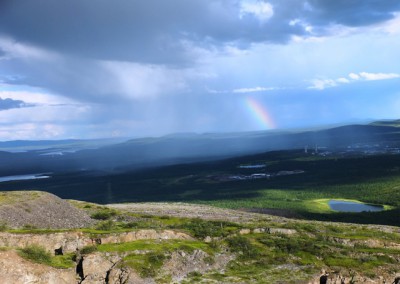We’ve been away, travelling, but it’s hard to miss the season of light in Kiruna. Elsewhere there may be warm weather, water to swim in, beaches to walk on, buildings to admire, but there is never enough light. All too early the switch to darkness comes. It never truly feels like summer.
Here we returned to rain clouds, cool temperatures, biting flies and midges, but there was the magic light, the day continuing for as long as you want. A minute can extend to hours, with no shifting daylight pattern to demand some change of activity. As in the darkness of winter, there is much time spent just wondering, and looking.
Unfortunately this has given us a lot of time to observe the behaviour of a group of pigeons that have recently arrived in the area. In our absence they made home on our roof, relieving themselves with abandon on our balcony below. Our roof was the perfect pitch for observing their food source, our elderly neighbour. Her reply when we suggested there might be a problem was, ‘well, they have to eat’.
So we were driven to more desperate measures. I drew large circular eyes on paper and hung them on the fence. I fixed some on the end of a pole and waved them furiously at the pigeons. At first they flew off in a panic but slowly they adapted to the eyes, saw they were no threat.
I didn’t remember seeing any pigeons here before. Surely they wouldn’t cope with the winter, I thought, hopefully. But they do, apparently. All they need is a dry home – they live as well in the arctic as they do in Trafalgar Square in London.
So we needed to revert to a more appropriate local reaction to the problem, and that is, live and let live. We persuaded our neighbour to move the food further away, so now the growing flock of pigeons are less likely to be on our roof. Still, it bothers me just to see them. The pigeon is such an urban, uninteresting bird.. why should it flourish here? Because it’s clever and easily trained. It remembers someone who puts out food, and it’s patient enough to wait for it. And it isn’t easily fooled by a fake pair of bird eyes.
It takes a couple of weeks of being in Kiruna before I feel at home. There’s a calmer, more pragmatic feel about life. With no pressure on land or resources here it’s more natural to live and let live, to accept the way things are.
One could feel annoyed in the summer about all the careless debris spread around. The broken down cars; the hardly-ever-used-but-it-might-one-day-be-handy machinery clogging up front yards; the stores of building materials being kept, just in case; the large tin cans, cables, rusting ironwork lying by the roadside. Add to that the building of Kiruna’s new centre – well, at least, it’s new town hall – and you have a town that resembles a very ugly building site. That’s Kiruna in the summer – an ugly grey pigeon making no effort to be pretty. In the winter it will turn into a beautiful white bird, a ‘giron’, but in the summer, a pigeon it is.
Still, you only have to step a few minutes away to be in an undisturbed landscape. buzzing with new life, sharp green fresh growth, colourful flowers and sweet smells. South of here the summer has brought a dull green pause, but Kiruna summer’s only just getting going and everything is as fresh as a daisy.
The easy route into this paradise is any of the town’s ski paths. Peaceful paths through the landscape, winding and dipping, secret and inviting.
I use them often and should be able to find my way but they’re more like a maze than a route. So many paths and tracks are revealed in the summer – from hunting, cycling, or just plain walking – that it’s hard to know which track you’re on. Maps aren’t much use either. The routes look clear enough but bear little resemblance to reality.
Since you could walk for hours and not see anyone, or any sign, you’d think this would be worrying, but it isn’t. Released from any intention to go from a to b, and freed from the fear of darkness, I’m quite relaxed about getting lost. Whatever happens I can always find my way home by looking at the landscape around. I’m familiar with the hills and valleys, the small lakes in the distance, the landmarks of town on the horizon. This, I realise, is unusual in the days of navigation apps.
Running on these tracks I don’t really know where I am most of the time but I don’t have to worry about finding the path home. I can see Luossavaara and the unfinished hotel building on its peak, and I see I’m behind it and to the right, so I bear left.
I can explore with a feeling of freedom it’s hard to experience in a more populated place. I’m just enjoying being our there, with no particular goal, and then, instinctively, heading for home. Like a homing pigeon. Live and let live.


